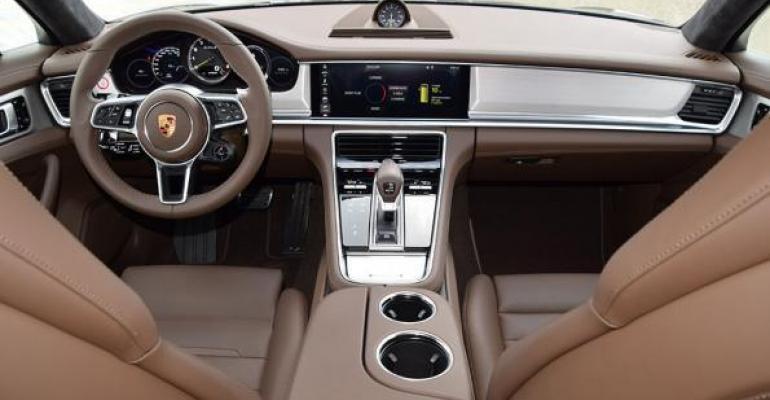A well-heeled shopper wanting a European flagship luxury sedan might be tempted to view the BMW 7-Series, Mercedes S-Class or Audi A8 as the only serious contenders with the spacious ambience required in this segment.
But the Porsche Panamera is another option for performance-minded enthusiasts willing to sacrifice some interior volume for driving dynamics. Its fully redesigned passenger compartment conveys a sleek tension that is meant to be experienced behind the steering wheel.
The Panamera earns a spot on the 2018 Wards 10 Best Interiors list for reinventing the cabin of the second-generation Panamera and infusing it with rich leather, premium brushed aluminum and a no-nonsense aesthetic that pays homage to decades of Porsche sports cars.
Peeking into its cabin, the monochromatic saddle brown leather and pyramid array of five gauges in the instrument cluster make it readily apparent the Panamera means business. And check out the fixed, boomerang-shaped head restraints like those attached to racing seats. You won’t find those in any of the German rivals.
Our Panamera Turbo S E-Hybrid test model, built in Leipzig, arrived with expert fit-and-finish, first-rate massaging seats and a $201,540 price, but much of that tag stems from the 4.0L twin-turbo V-8 and hybrid powertrain generating 680 hp. Panamera pricing starts much lower, at $85,000.
The biggest change in this interior is the fully redesigned Porsche Communication Management System. Panamera is the first vehicle in the brand’s stable to deploy it. The third-generation Cayenne gets it later this year.
The system integrates a new 12.3-in. (31-cm) touchscreen with many of the controls that used to occupy two long angular rows of buttons and switches that cluttered the center console in the previous Panamera.
Like every good HMI, there’s redundancy for drivers who want multiple ways to interact with the vehicle and control certain functions.
In addition to the touchscreen, the driver can use capacitive switches embedded within an acrylic black surface near the shifter to control climate, seat heating and suspension settings. The new design makes for a much cleaner look overall.
The instrument cluster is reconfigurable, and the pyramid stack of what appears to be five individual gauges is an illusion. There’s only one fixed gauge – an analog tachometer prominently placed in the center – and it’s flanked by two 7-in. (17.8-cm) screens that can be controlled by steering-wheel switches.
At startup, each 7-in. screen displays two information gauges, but they can be set in multiple configurations, with “Speed & Assist” functions on the left, “Car & Info” on the right. The entire right screen can display a navigation map or, when needed, night vision (part of a $5,370 driver-assistance package that includes lane keeping and adaptive cruise control).
For those owners who will hire a driver, a rear seat entertainment system is available, and second-row occupants have their own control panel for climate and radio selections, as well as deploying a rear privacy screen. If you need more room, there’s a long-wheelbase Executive version.
Add it all up and this amounts to a completely new user experience that enhances the Panamera and makes Porsche much more than a company that merely makes fast cars.





